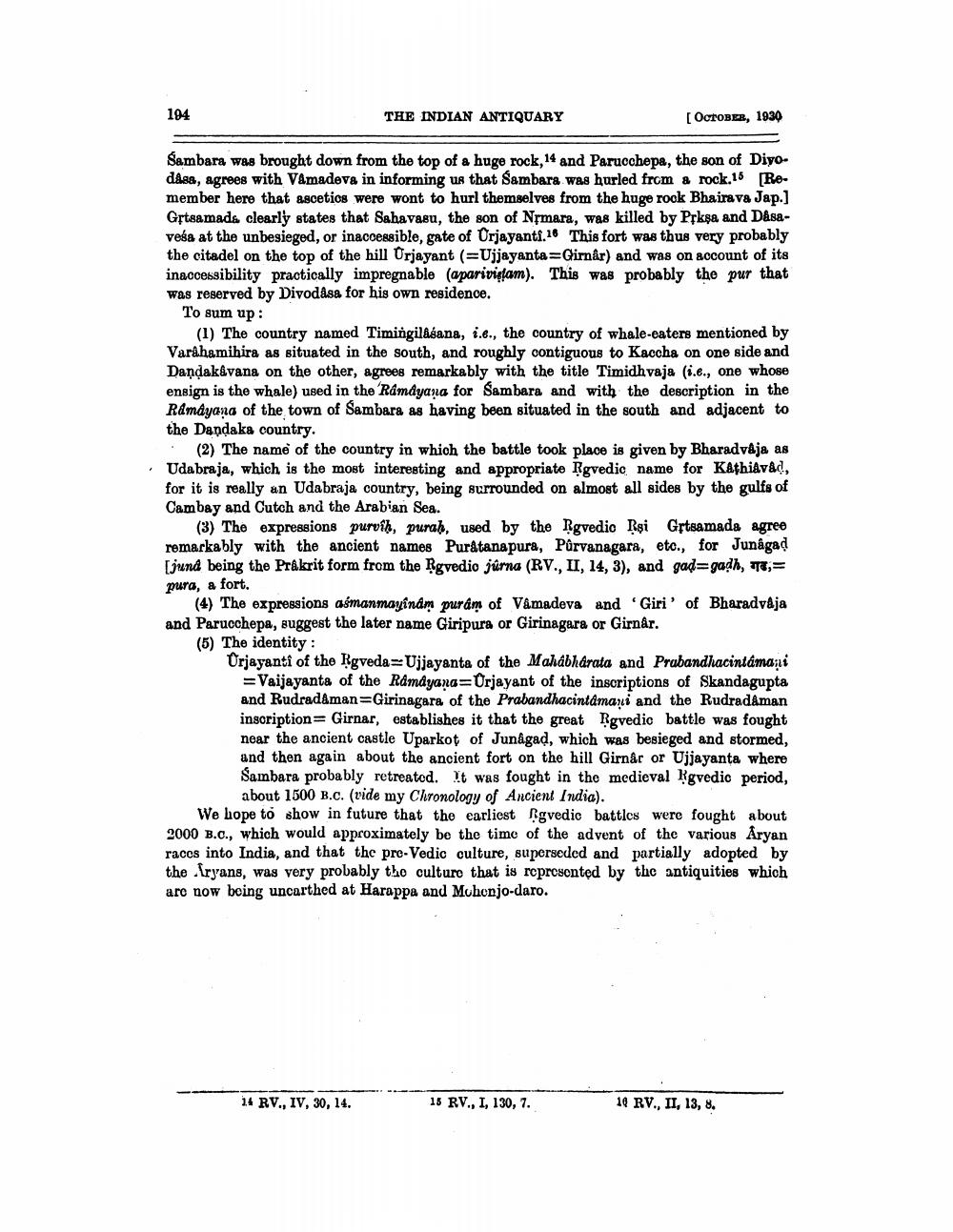________________
194
THE INDIAN ANTIQUARY
[OCTOBER, 1930
Sambara was brought down from the top of a huge rock, 14 and Parucchepa, the son of Diyodåsa, agrees with V&madeva in informing us that Sambara was hurled from & rock.15 Remember here that ascetios were wont to hurl themselves from the huge rook Bhairava Jap.] Gștsamads clearly states that Sahavasu, the son of NȚmara, was killed by Ppkşa and Dåsaveša at the unbesieged, or inaccessible, gate of Urjayanti.16 This fort was thus very probably the citadel on the top of the hill Orjayant (=Ujjayanta=Girnar) and was on account of its inaccessibility practically impregnable (aparivizam). This was probably the pur that was reserved by Divodása for his own residence. To sum up:
(1) The country named Timingilâsana, i.e., the country of whale-eaters mentioned by Varahamihira as situated in the south, and roughly contiguous to Kaccha on one side and Dandakavana on the other, agrees remarkably with the title Timidh vaja (i.e., one whose ensign is the whale) used in the 'Ramdyana for Sambara and with the description in the Ramayana of the town of Sambara as having been situated in the south and adjacent to the Dandaka country. . (2) The name of the country in which the battle took place is given by Bharadvaja as Udabraja, which is the most interesting and appropriate Rgvedio name for Kathiavac, for it is really an Udabraja country, being surrounded on almost all sides by the gulfs of Cambay and Cutch and the Arabian Sea.
(3) The expressions purvin, punah, used by the Rgvedio Rşi Grtsamada agree remarkably with the ancient names Purátanapura, Pârvanagara, etc., for Junagad [jund being the Prakrit form from the Rgvedio júrna (RV., II, 14, 3), and gad=gadh, Ta= pura, a fort.
(4) The expressions aśmanmayinám puram of Vámadeva and 'Giri' of Bharadvaja and Parucchepa, suggest the later name Giripura or Girinagara or Girnar. (5) The identity : Urjayanti of the Rgveda-Ujjayanta of the Mahabharata and Prabandhacintamani
=Vaijayanta of the Ramdyana=Orjayant of the inscriptions of Skandagupta and Rudrad&man=Girinagara of the Prabandhacintámari and the Rudradaman inscription= Girnar, establishes it that the great Rgvedic battle was fought near the ancient castle Uparkot of Junagad, which was besieged and stormed, and then again about the ancient fort on the hill Girnår or Ujjayanta where Sambara probably retreatod. It was fought in the medieval Rgvedic period,
about 1500 B.C. (vide my Chronology of Ancient India). We hope to show in future that the earliest Rgvedic battles were fought about 2000 B.C., which would approximately be the time of the advent of the various Aryan races into India, and that the pre-Vedic culture, superseded and partially adopted by the Iryans, was very probably the culture that is represented by thc antiquities which are now being uncarthed at Harappa and Mohenjo-daro.
14 RV., IV, 30, 14.
15 RV., I, 130, 7.
10 RV., II, 13, 8.




